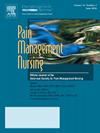Development and Implementation of the FAST-PACE Assessment Framework and Tiered Analgesic Orders for Opioid Optimization
IF 1.6
4区 医学
Q2 NURSING
引用次数: 0
Abstract
Purpose
The purpose of this presentation is to share how one academic medical center adopted a holistic pain assessment framework and multimodal order sets to guide administration of analgesic therapies.
Summary of Evidence
Significant patient harms have been attributed to opioids, so stewardship programs are required. The CDC and an international panel of health care professionals recommends administering opioids to functional outcomes. Change was instigated by revised inpatient order sets and creation of a holistic framework. These methods aim to address patient-specific recovery goals and minimize long and short-term adverse effects while support nursing practice.
Validation of Evidence
Revised opioid-sparing order sets and staff and patient education modules will be reviewed. Analysis of how FAST-PACE guides prescribing or administering analgesia will be described. Learn how Plan-Do-Study-Act process improvement guides ongoing interdisciplinary Opioid Optimization workgroup actions. Consider preparation for a second regulatory survey since implementing this practice change. Discuss importance of just-in-time education to support clinician, and patient/caregiver adoption of this evidence-based process.
Results/Relevance to Pain Management
Revised opioid-sparing order sets rolled out in March of 2022; A significant practice change entailing ongoing evaluation and reinforcement. No patient harms have been directly attributed to this practice change. Metrics to measure quality, safety and nursing adherence to the tiered approach are underway. Existing EPIC workbench reports display 80-90% provider conformity to the tiered, multimodal approach.
Future Implications for Nursing Practice
Changing from the former ubiquitous method of dosing opioids to pain intensity scores will take time. Both patients and staff will benefit from routine reinforcement and rationale for this practice change. Patient well-being, function, and risk mitigation are the driving forces behind this initiative.
求助全文
约1分钟内获得全文
求助全文
来源期刊

Pain Management Nursing
医学-护理
CiteScore
3.00
自引率
5.90%
发文量
187
审稿时长
>12 weeks
期刊介绍:
This peer-reviewed journal offers a unique focus on the realm of pain management as it applies to nursing. Original and review articles from experts in the field offer key insights in the areas of clinical practice, advocacy, education, administration, and research. Additional features include practice guidelines and pharmacology updates.
 求助内容:
求助内容: 应助结果提醒方式:
应助结果提醒方式:


